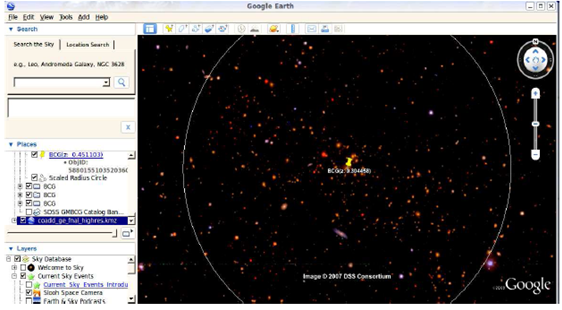Google Sky Gains Galaxy Cluster Data
Use Google Earth in sky mode and you immediately gain access to an impressive set of images of the universe. Animations show the movement of the planets across the sky and there is an option to superimpose images from the Hubble Space Telescope over the relevant regions of the cosmos.

All in all, an impressive experience. But there’s still room for improvement, say Jiangang Hao and James Annis at the Fermi National Accelerator Laboratory in Batavia. They point out that Google uses low resolution images of the night sky to improve the speed at which they load. The result is that Google Sky shows only a small fraction of the galaxy clusters that have been photographed to date.
To set this wrong to rights, Hao and Annis have converted the high resolution images of a section of the night sky into the Keyhole Markup Language (.KML files) which anyone can download and view using Google Sky. Hao and Annis have used images from the Sloan Digital Sky Survey showing galaxies with a redshift of up to 1. In other words, from a time when the universe was half the size it is now. All you have to do is download them (all the links and instructions are in the paper linked to below).
Hao and Annis provide the images at three levels of resolution so you can choose the size of the files you want to download. The extra detail is significant and Google Sky allows you to fly across the galaxy clusters (although not through them in 3D).
The question now is what this new representation of the data allows that hasn’t yet been done. A couple of months ago we looked at the way open source and free software is being used to spot new impact craters on Earth using Google Maps. There’s no reason why image processing software and some innovative number crunching won’t pay out in silver dollars for anyone willing to invest the time and brainpower in galaxy clusters.
The exciting potential of this work is that it democratises astronomy: anyone, anywhere on the planet can have a go. That represents an awful lot of potential brainpower.
Have fun!
Ref: arxiv.org/abs/1010.6068 : Flying Across Galaxy Clusters With Google Earth: Additional Imagery From SDSS Co-Added Data
Keep Reading
Most Popular
Large language models can do jaw-dropping things. But nobody knows exactly why.
And that's a problem. Figuring it out is one of the biggest scientific puzzles of our time and a crucial step towards controlling more powerful future models.
How scientists traced a mysterious covid case back to six toilets
When wastewater surveillance turns into a hunt for a single infected individual, the ethics get tricky.
The problem with plug-in hybrids? Their drivers.
Plug-in hybrids are often sold as a transition to EVs, but new data from Europe shows we’re still underestimating the emissions they produce.
Stay connected
Get the latest updates from
MIT Technology Review
Discover special offers, top stories, upcoming events, and more.